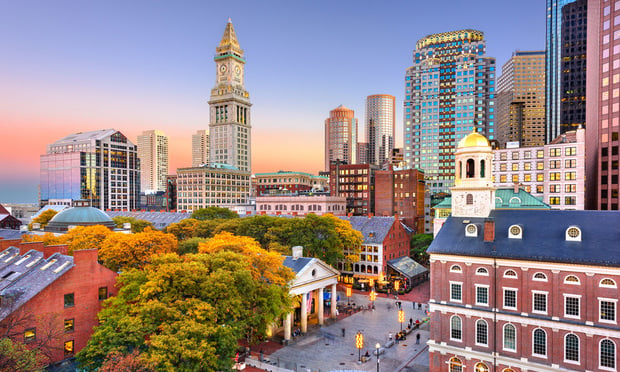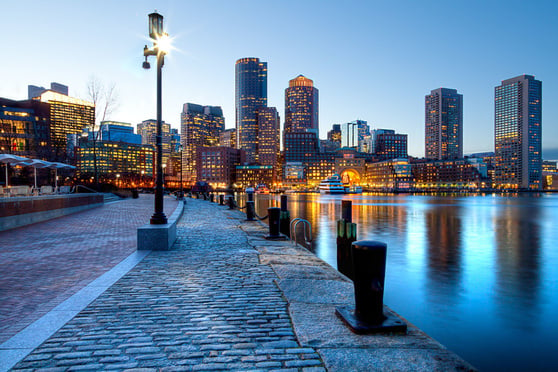BOSTON—The Greater Boston laboratory real estate market continues its hot streak and prevailing trend lines, specifically low vacancy and availability rates, despite new construction delivered and in the pipeline.
A year-end market report by brokerage firm Transwestern states that at the end of 2016, the 20-million-square-foot lab market in Greater Boston sported an availability rate of 5.9%, up from 4.7% six months earlier, and a vacancy rate of just 4.4%. The laboratory market availability rate for Greater Boston was well below the five-year running average of 9.9%, according to Chase Bourdelaise, Northeast director of research for Transwestern.
The availability rate for lab space in the City of Boston at year-end was 2.5%, as was the city's vacancy rate. In space-constrained Cambridge, the availability rate was 4.5% at the end of 2016 and the vacancy rate stood at just 3.3%.
“It's great to see the laboratory market continuing its long streak of positive results, though there is a related consequence of certain areas being significantly space-constrained,” Bourdelaise said. “It's notable that we have had very tight market conditions for an extended period of time, even as new space is being added to the inventory each year.”
Some of the key takeaways from the Transwestern report include that 1.4 million square feet of lab and research space is currently under construction in Greater Boston. The region is also for the most part sporting below double-digit vacancy and availability rates, despite the fact that 523,000 square feet was added to the regional lab inventory. The average asking rent in Cambridge reached a record high of $72.15-a-square-foot at the end of 2016.
Bourdelaise relates that despite an availability rate of 11.3% and a vacancy rate of 8.1% at the end of last year, the suburban Boston market is heating up with a higher rate of lease and sales deals.
“There is no bigger reason for the lab market's success than the talent that surrounds it,” Bourdelaise states in the report. “With prestigious universities, such as Harvard and MIT, along with a handful of large life science companies in the area, it is only natural for the life sciences industry to flourish.” He adds that many are life science companies are engaging in expansion programs, and despite 973,000 square feet of new space under construction in East Cambridge, that market is “vacancy starved.”
“With room to grow and lower pries to do so, look for the inner suburbs and the Seaport District to reap the benefits of the demand spillover, he predicts.
BOSTON—The Greater Boston laboratory real estate market continues its hot streak and prevailing trend lines, specifically low vacancy and availability rates, despite new construction delivered and in the pipeline.
A year-end market report by brokerage firm Transwestern states that at the end of 2016, the 20-million-square-foot lab market in Greater Boston sported an availability rate of 5.9%, up from 4.7% six months earlier, and a vacancy rate of just 4.4%. The laboratory market availability rate for Greater Boston was well below the five-year running average of 9.9%, according to Chase Bourdelaise, Northeast director of research for Transwestern.
The availability rate for lab space in the City of Boston at year-end was 2.5%, as was the city's vacancy rate. In space-constrained Cambridge, the availability rate was 4.5% at the end of 2016 and the vacancy rate stood at just 3.3%.
“It's great to see the laboratory market continuing its long streak of positive results, though there is a related consequence of certain areas being significantly space-constrained,” Bourdelaise said. “It's notable that we have had very tight market conditions for an extended period of time, even as new space is being added to the inventory each year.”
Some of the key takeaways from the Transwestern report include that 1.4 million square feet of lab and research space is currently under construction in Greater Boston. The region is also for the most part sporting below double-digit vacancy and availability rates, despite the fact that 523,000 square feet was added to the regional lab inventory. The average asking rent in Cambridge reached a record high of $72.15-a-square-foot at the end of 2016.
Bourdelaise relates that despite an availability rate of 11.3% and a vacancy rate of 8.1% at the end of last year, the suburban Boston market is heating up with a higher rate of lease and sales deals.
“There is no bigger reason for the lab market's success than the talent that surrounds it,” Bourdelaise states in the report. “With prestigious universities, such as Harvard and MIT, along with a handful of large life science companies in the area, it is only natural for the life sciences industry to flourish.” He adds that many are life science companies are engaging in expansion programs, and despite 973,000 square feet of new space under construction in East Cambridge, that market is “vacancy starved.”
“With room to grow and lower pries to do so, look for the inner suburbs and the Seaport District to reap the benefits of the demand spillover, he predicts.
Want to continue reading?
Become a Free ALM Digital Reader.
Once you are an ALM Digital Member, you’ll receive:
- Breaking commercial real estate news and analysis, on-site and via our newsletters and custom alerts
- Educational webcasts, white papers, and ebooks from industry thought leaders
- Critical coverage of the property casualty insurance and financial advisory markets on our other ALM sites, PropertyCasualty360 and ThinkAdvisor
Already have an account? Sign In Now
*May exclude premium content© 2024 ALM Global, LLC, All Rights Reserved. Request academic re-use from www.copyright.com. All other uses, submit a request to [email protected]. For more information visit Asset & Logo Licensing.









